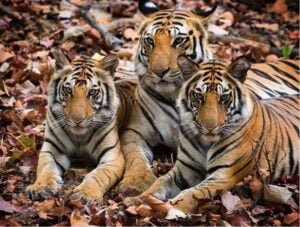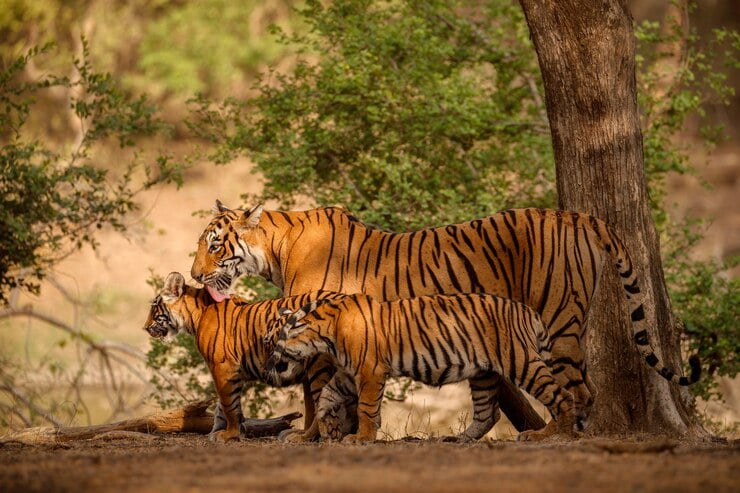No products in the cart.
BANDHAVGARH NATIONAL PARK
Madhya Pradesh
Tiger, Tiger Burning Bright…
One of the world’s best tiger-spotting destinations, India, witnesses the arrival of wildlife buffs from all over the globe. In the cool winter months game sanctuaries and national parks open up to visitors for fantastic opportunities to explore the country’s faunal, avifaunal, and botanical heritage across varied geographies of the sub-continent.
India is home to 75 percent of the world’s tiger population—The tiger census pegged at an interim estimation of 3,167 in April to commemorate the completion of 50 years of Project Tiger. The 2022 census was places the tiger population now at 3,682 according to the latest data released on

International Tiger Day, on July 29, 2023. Project Tiger was established to utilize the tiger’s functional role and charisma to garner public support and resources for preserving the representative ecosystems. Since its inception, the project has expanded from nine tiger reserves to53 reserves in India. With a 50 percent increase over the last four years, Madhya Pradesh has the maximum number (785) of tigers in the country, followed by Karnataka (563), Uttarakhand (560), and Maharashtra (444), according to the data.
Bandhavgarh National Park in Madhya Pradesh is loved for being one of the best places for excellent sightings of the apex predator of the Indian jungles. That’s because it’s got the highest density of India’s tiger population and its natural terrain makes it easier to spot them. Vast expanses of open savannah grasslands, shrubs, and swampy meadows (bohera) dominate this natural habitat which also features large swathes of sal forests. Located in Umaria district the 448 sq km sprawl of Bandhavgarh National Park is dominated by Bandhavgarh Hill surrounded by smaller hills serrated by gently sloping valleys. Bandhavgarh is home to over 22 species of mammals and 250 species of avifauna.
These virgin forests were once the private hunting preserves of the rulers of Rewa the original home of the rare white tiger. However, the only white tigers you can observe now reside in zoos and they are descendants of Mohun, the last white tiger of the wild. The last white tiger was an orphan cub captured from the Bagri Forest in Bandhavgarh in 1951 by Maharaja Martand Singh. The cub grew up to be called Mohan and sired many white tigers who were later shipped off abroad. White tigers are a result of a genetic aberration that occurs due to mutant recessive genes in both parents which give them the black stripes and blue eyes. These are not albinos as originally thought. Conservation measures at game preserve were set in by the government in 1968 when it came under the newly constituted National Park. it was declared (1993) a Tiger Reserve under the umbrella of the prestigious Project Tiger, launched worldwide in 1972.
The park can be accessed by four entry points— Panpatha in the north, Tala (where most hotels are located) in the east, Dhamokar on the south-western perimeter, and Khitauli in the west. The over 2000-year-old Bandhavgarh Fort is now out of bounds as it’s a nursery of sorts chosen by the resident tigresses. You’ll probably miss the chance to view the superb 10th-century reclining Vishnu on the semi-divine
serpent Shesha Nag, carved out of a single rock dating, that is housed here. There are several caves scattered across the park bearing Brahmi inscriptions from the1s BCE.
Safaris
Specific tourist routes have been earmarked in the National Park for jeep safaris, which need to be accompanied by a forest ranger.
Safaris are available in the morning and afternoon. Open October to June
Park Timings 6-10 am- 3-5.30 pm Contact Wildlife/ Forest Dept *Field Director, Umaria Tel: 07653-222214
Accommodation
Bandhavgarh’s new and established hotels, all of which are in Tala, cater for travellers on a higher budget and offer & jungle-plan prices – all-in deals including meals and jeep safaris. There’s a handful of mid-range hotels and a few budget options as well.
Access
Air: Nearest airport is Jabalpur (5hrs) Onward journey by taxi.
Rail: Nearest railhead is Jabalpur (164 km), but also Katni (102 km) which falls on the Central Railway route, and Umaria (35km) on the South Eastern Railway line.
Road: State/Private buses ply between Katni, Umaria and Satna and Rewa.
















